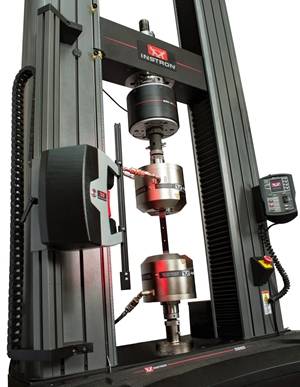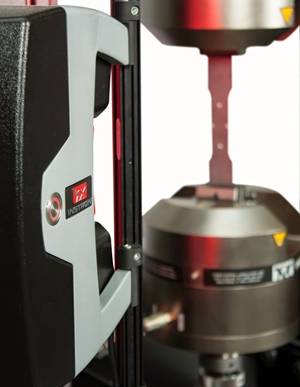The world of materials testing is changing
- materials are getting stronger, stiffer, and lighter
- test standards are becoming stricter
- testing labs are asked to perform more complex analytical tests
With all of these changes affecting the way labs test, it’s important to think about the following questions: How does your lab environment challenge test results? Is your lab equipped to handle the new strength of specimens? Are you testing under load or position control parameters, or do you require the use of strain control?
These questions, when coupled with the changes above, are all factors we have discussed with our customers and are sharing with you.
Challenge #1
AVE 2 Carbon Fiber LaminatesThe automotive and aerospace industries are growing and demanding that materials become stiffer, stronger, and lighter. This new breed of materials is helping the industry produce lighter and stronger products, but lab operators are finding that the large energy release may damage contacting extensometers. To reduce the cost of maintenance for labs testing these challenging materials, video extensometers are an ideal solution – they don’t contact the material, and therefore, they are unaffected by the high-energy breaks of materials, such as carbon fiber composites or rebar.
Challenge #2
With the growing demands come newer standards that place stricter requirements on the type of extensometer you are allowed to use. For example, ISO 527-2012 now requires that devices have an accuracy of just 1 micron in order to measure the modulus of the material. 1 micron is exceptionally small (about 100 times smaller than the width of the average human hair) and is exceedingly difficult to measure. Although this accuracy can be attained with some traditional clip-on extensometers, clip-ons have limited travel and typically can’t measure strain through failure for ductile specimens. In addition, they may cause premature failure due to stress risers from knife edge contact.
Until recently, there hasn't been a video device that could meet the new standard requirement due to problems with lighting and air flow that naturally occurs within a lab, which ultimately affects the device’s ability to provide accurate results.
To prevent the lab lighting from making a difference, we have incorporated a patented lighting system into our new video extensometer that floods the specimen with polarized light and use a polarized filter on the lens. This enables the video extensometer to produce consistent results no matter the lighting conditions, including flicker from fluorescent lights or the difference in lighting from a lab window.
Secondly, all video systems are affected by air flows in the room from sources like air ducts and heat sources. These air flows are similar to what you may see on asphalt on a hot day. The air currents and heat sources in your lab are probably much smaller, but since 1 micron is so small even minor perturbations make the measurement impossible. Our engineers incorporated a patented system of fans into the video extensometer to prevent these air flows between the specimen and the camera, enabling the test to yield accurate results whether your air system is off or running at full speed.

Challenge #3
AVE 2 Metals SpecimenNew standards are also placing requirements on the way that tests are being controlled. In the past, most – if not all – tests were run under load or position control parameters, but newer standards may prefer or require the use of strain control. This can be done with contacting extensometers, while pre-existing video extensometers struggle to run strain control tests because the images taken have to be processed by the computer and then sent to the software to adjust the frame movement accordingly. There is a large delay between the images being taken and the processing by the computer, which means that by the time the frame reacts to the strain measurement the value has changed.
To resolve this, the new video extensometer now measures strain at the camera in real time and then sends the data directly to your test frame. This drastically reduces the response time of the camera and allows for clean strain control.
Challenge #4
Extensometers are excellent for materials testing, but only give you a point-to-point measurement. Other measurement techniques, such as digital image correlation, can give you more information about material behavior during a mechanical test, but they typically require expensive and complicated equipment and software. Because of the high barrier to entry, only a few labs take advantage of this technology and are able to make key insights about their material behavior that other labs can’t.
Instron has lowered the barrier to entry for digital image correlation by offering our video extensometers along with dedicated digital image correlation software. The extensometer images are automatically synchronized in time to the data from the load frame, which means that you can now run a test and begin producing full field strain maps in less than one minute.
